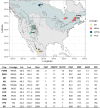Characterizing genetic adaptations and plastic stress responses within a transcontinental North American keystone species
- PMID: 40689573
- PMCID: PMC12381763
- DOI: 10.1093/treephys/tpaf087
Characterizing genetic adaptations and plastic stress responses within a transcontinental North American keystone species
Abstract
Local adaptation can lead to the intraspecific variation in a species' genetic makeup, shaping both its physiological and morphological traits as well as its molecular responses. In this study, we assessed variation in key functional leaf traits, such as stomata density, carbon and nitrogen content, cuticular wax composition and leaf shapes, within the transcontinental North American Populus tremuloides Michaux (quaking aspen) by sampling individuals from its four major genetic lineages. We also performed a small-scale common garden experiment with imposed higher temperature and drought stress during which we sampled for transcriptomes using RNAseq and performed physiological measurements to obtain insights into the intraspecific responses among aspen lineages to such abiotic stressors. Our findings revealed several differences in functional traits indicative of local adaptation, such as variation in cuticular wax content, petiole lengths and δ13C. Notably, stomatal density was significantly associated with mean annual precipitation. Moreover, genotypes from the most southern lineage (Mexico) exhibited the largest decline in net photosynthesis under drought, suggesting a more conservative water-use strategy. Gene expression analyses revealed numerous differentially expressed genes under different stress conditions and in different lineages, with overlaps with previous gene selection scans, confirming their possible roles in local adaptation. Weighted gene co-expression network analysis further identified 22 co-expressed gene modules, several of which strongly associated with temperature responses and geographic origin of genetic lineage. Our findings highlight substantial intraspecific variation in functional traits and gene expression patterns in P. tremuloides linked to geographical origin and local environmental conditions. Understanding such adaptive variation is crucial for predicting how forest trees may cope with and adapt to the challenges of climate change.
Keywords: abiotic stress; cuticular wax; physiology; quaking aspen; stomata; transcriptome.
© The Author(s) 2025. Published by Oxford University Press.
Conflict of interest statement
None declared.
Figures









References
-
- Adams WW, Stewart JJ, Cohu CM, Muller O, Demmig-Adams B (2016) Habitat temperature and precipitation of Arabidopsis thaliana ecotypes determine the response of foliar vasculature, photosynthesis, and transpiration to growth temperature. Front Plant Sci 7:1–18. 10.3389/fpls.2016.01026. - DOI - PMC - PubMed
-
- Aubin I, Munson AD, Cardou F et al. (2016) Traits to stay, traits to move: a review of functional traits to assess sensitivity and adaptive capacity of temperate and boreal trees to climate change. Environ Rev 24:164–186. 10.1139/er-2015-0072. - DOI
-
- Benjamini Y, Hochberg Y (1995) Controlling the false discovery rate: a practical and powerful approach to multiple testing. J R Stat Soc 57:289–300. 10.1111/j.2517-6161.1995.tb02031.x. - DOI
MeSH terms
Grants and funding
- RGPIN/04748-2017/Natural Sciences and Engineering Research Council of Canada
- RGPIN/04772-2019/Natural Sciences and Engineering Research Council of Canada
- CONACYT-FRQ-2016 - 279459/Secretaría de Ciencia, Humanidades, Tecnología e Innovación Secihti, México
- JELF 38063/The Canadian Foundation for Innovation John R. Evans Leaders Fund
- Digital Alliance of Canada
LinkOut - more resources
Full Text Sources

